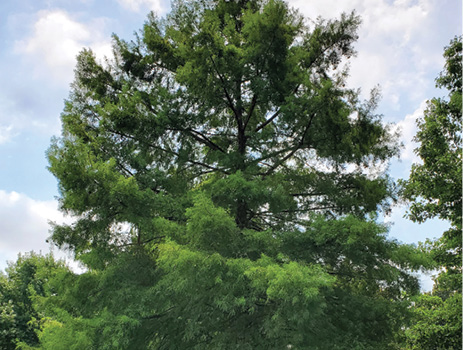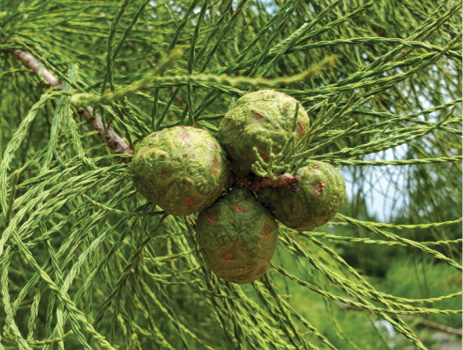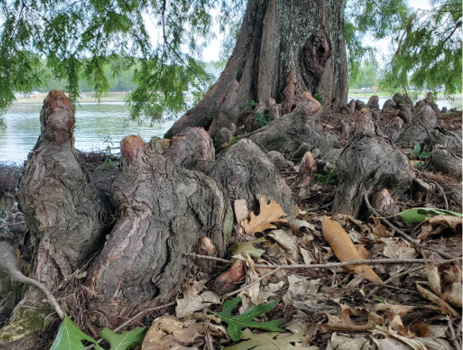Bald Cypress | Taxodium distichum
Emergent | Native



This native tree is an iconic lowland species in Mississippi. It is one of the few deciduous conifers in North America. Bald cypress can reach 100 feet in height and have trunk diameters of up to 8 feet. In wet areas, they develop distinctive woody “knees” from their root systems, which can protrude from the trunk.
The thin, light-green leaves can appear feather-like. They are tightly and oppositely arranged along both sides of small branchlets (2 to 4 inches in length). In autumn, the trees turn copper to reddish-brown before the entire branchlet falls to the ground with some leaves still attached.
This tree species is monoecious, which means that each tree has both male and female reproductive parts. The male catkin is about 4 inches long with clusters of small, purplish conelets. The female conelets feature one to three clusters. They turn from green to brownish-purple as they mature, and reach about 1 inch in diameter.
Management Value
Bald cypress is a beautiful tree that can improve the aesthetics of aquatic wetlands and ponds. It prefers full sunlight. If planted in pond environments, avoid areas near the levee, as the roots can destabilize water seal. Keep in mind that these trees grow very large, and the knees may obstruct some pond and shoreline use.
Many bird species use individual and groves of bald cypress for roosting and nesting habitat, especially bald eagles, ospreys, and prothonotary warblers. Squirrels, turkeys, wood ducks, and other bird species eat the seeds. The trunks and knees make excellent fish habitat when flooded. Hollow areas and fallen logs are often used by catfish species as nesting cavities.
The wood from bald cypress is very durable when exposed to the elements. It is popular for exterior trim, shingles, boat building, fence posts, and shredded mulch.
Recommended Controls
Some consider pond cypress to be a different species, but its value and controls are the same as bald cypress.
Killing large trees is best achieved by felling the tree with a chainsaw, followed by applying a systemic herbicide solution to the root stump immediately after the tree is felled. This will allow the tree to take up the herbicide and distribute it to the root system.
Option 1: Imazapyr (2.0-pound formulation). For each gallon of water, mix 12 ounces imazapyr. Spray or brush solution on the cambium of the cut stump. Cambium is the wood immediately under the bark at the outer edge of a stump. Take note of nearby tree species (specifically oaks) as imazapyr is soil active. This means that imazapyr can travel through the stump to roots and release into the surrounding soil, harming any nearby trees. Do not exceed annual herbicide rate limits as stated on the product label.
Option 2: Glyphosate (5.4-pound formulation). For young trees and seedlings: for each gallon of water, mix 1.9 ounces of glyphosate and 1.3 ounces of surfactant; apply solution to leaves. Spray to wet all exposed plants. Do not exceed annual herbicide rate limits as stated on the product label.
Read and follow all chemical label instructions, especially the section on the use of personal protection equipment.

The information given here is for educational purposes only. References to commercial products, trade names, or suppliers are made with the understanding that no endorsement is implied and that no discrimination against other products or suppliers is intended.
Publication 3735-18 (POD-11-23)
By Wes Neal, PhD, Extension/Research Professor, Wildlife, Fisheries, and Aquaculture; Dennis Riecke, Fisheries Coordinator, Mississippi Department of Wildlife, Fisheries, and Parks; and Gray Turnage, PhD, Assistant Research/Extension Professor, GeoSystems Research Institute.
The Mississippi State University Extension Service is working to ensure all web content is accessible to all users. If you need assistance accessing any of our content, please email the webteam or call 662-325-2262.



